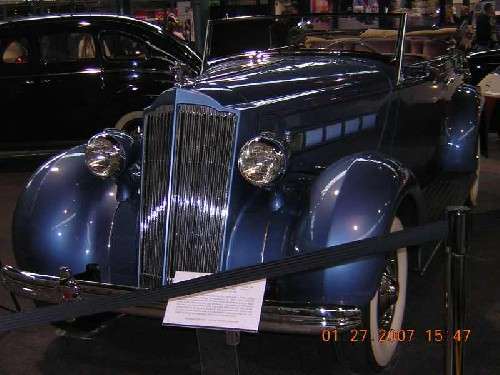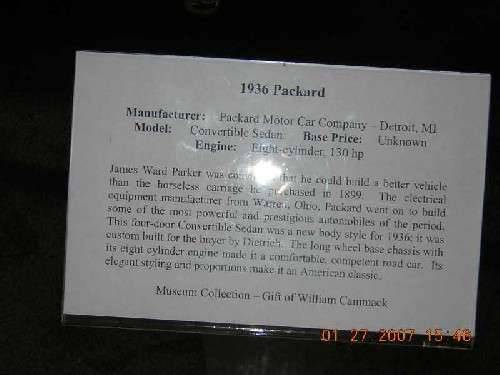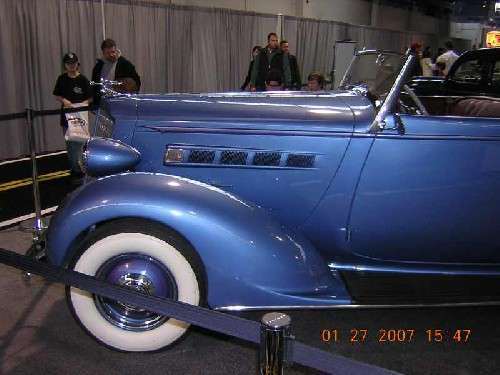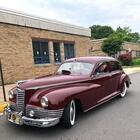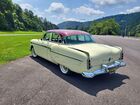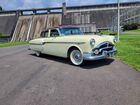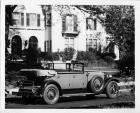|
Anonymous
|
AACA Museum's Packard
|
|||
|---|---|---|---|---|
|
Guest_Anonymous
|
Hello John and the others who have commented on the AACA Museum's Packard:
First, thanks for visiting the Harrisburg Auto Show and taking time to view our exhibition. Attracting positive attention for the Museum is the reason we were there! I hope you liked the other cars we had on display with the Packard. As a museum professional I take my job seriously. I am a trained museum curator with a long history of employment in this field. If I am an "expert" on anything that is it. I am also a long-time antique automobile enthusiast and a member of the AACA. You guys on this forum are here because of your specific knowledge and interest in Packards. At the Museum we are fortunate to have a large and diverse antique vehicle collection, all donated by folks like you. This collection grows every year. To write a meaningful 8 line label for each car is sometimes challenging. All of us here are basically generalists doing our best to get it right. We do not object when enthusiasts and visitors kindly point out our mistakes and oversights. If an error is documented, it is quickly corrected. In the case of the Packard, there are obviously a couple of typing errors and an incorrect date. These have been corrected and a new label is in place for this vehicle. As for whether the car is a 1936 or 1937, I honestly don't know. All of our registration and donation information for this car lists it as a 1936. That is the information I inherited and no one has ever questioned its year until now. If it truly is a 1937, we will correct that as well. To do this, I will need to know the distinguishing differences between the two years. Or, if someone who has commented on this lives close to us, I would welcome the opportunity to have them go over the car with me, pointing out the differences and possibly checking the VIN, if that will help in identification. I welcome the opportunity to increase my knowledge of Packards. Again, thanks for your interest in the AACA Museum. I look forward to receiving your help with this matter. Jeffrey Bliemeister, Curator jbliemeister@aacamuseum.org |
|||
|
||||
|
Anonymous
|
Re: AACA MUSEUM EXPERTS ?
|
|||
|---|---|---|---|---|
|
Guest_Anonymous
|
John,
I'll contact the Museum Director and point out their error. If you like you can contact them. Here is their contact information: AACA Museum 161 Museum Drive Hershey, PA 17033 Phone:717.566.7100 Fax:717.566.7300 e-mail:info@aacamuseum.org Either way I'm sure they'll fix it if neccessary. Thank you so much for pointing it out and being a gentleman about it. Peter |
|||
|
||||
|
Re: AACA MUSEUM EXPERTS ?
|
||||
|---|---|---|---|---|
|
Home away from home

|
Kevin: I know that the people at the display that day were
volunteers who certainly wouldn't have known. However I have been to AACA Museum a couple of times. I know that some of the people running the museum are paid employes, and the people from the museum probably transported the cars there to Harrisburg from Hershey and setup the display, being as the cars are part of the museums collections. There for the information printed on the signs also had to have been printed at the museum. I know every body makes mistakes, but having said that, the paid people running the museum and incharge of setting up the display are just being plain sloppy in doing there jobs. Its not the volunteers fault for the screw up, its the paided staff of the AACA that is the fault for this. If they are going to be paided to put fourth the history of this hobby, then they should pay attention to the fine details of things. John F. Shireman
Posted on: 2007/1/29 22:14
|
|||
|
||||
|
Re: AACA MUSEUM EXPERTS ?
|
||||
|---|---|---|---|---|
|
Webmaster
|
I'm sure the AACA relies on volunteers to help out with the displays and events.
I would imagine that not all of volunteers are experts in all of the cars. This was probably just a typo or an oversight by whomever was helping out with the sign creation. I agree that someone should be fact-checking those kind of things as it does reflect badly those kind of things happen. But hey, thats why pencils has erasers.
Posted on: 2007/1/29 21:26
|
|||
|
-BigKev
1954 Packard Clipper Deluxe Touring Sedan -> Registry | Project Blog 1937 Packard 115-C Convertible Coupe -> Registry | Project Blog |
||||
|
||||
|
AACA MUSEUM EXPERTS ?
|
||||
|---|---|---|---|---|
|
Home away from home

|
When this time of year comes around I always go to the new car show at in Harrisburg Penna. As is the case every year the AACA Museum located in Hershey allways has small display of cars. Again this year they were there putting on the same pitch for the AACA Museum. One of the cars that was on display that caught my attention was a Packard which they claimed was a 1936 Packard. I took a few pictures of the Packard which I posted earlier in another thread. In front of the car was a display sign telling about the car which I took a picture of but never bothered reading at the time.
Yesterday I went throught and did a review of the pictures I took. I decided to take a look at the picture of the sign they had in front of the Packard. After reading the information they posted and doing some more research, I just shook my head in dis-may and starting laughing at how dumb some so-called experts realy are. They stated that Packard was founded by James Ward Parker, and that he purchased his first car in 1899. They also gave some history of the Packard claiming that the Packard was a 1936 Packard Convertible Sedan. Here is what I found wrong with the information on the sign. Below in this thread are three pictures one of the Packard, the other of the dispaly sign in fornt of the 1937 Packards. The last picture posted is a side view of the Packard to proof that it is a 1937 as I have stated. 1. James Ward Parker never founded Packard as far as I know. 2. James Ward Packard who help found Packard purchased his first car in August 1898, which was a Winton. 3. The Packard they had on display turns out not to be a 1936 as they claimed. The Packard on display in actually a 1937 Convertible Sedan. There is just no excuse for this kind of mistake by the AACA, considering all the research material that they have in their library. John F. Shireman
Posted on: 2007/1/29 20:20
|
|||
|
||||
|
Re: 1955 & 1956 Packard Side Marker Lights
|
||||
|---|---|---|---|---|
|
Home away from home

|
My side marker (courtesy lights) just arrived from Joel Ray in Michigan. They are beautiful & perfect! Anyone wishing to replace theirs should drop Joel a line. I was referred to Joel via Minnesota Mike Dulinski in Duluth.
Posted on: 2007/1/26 21:36
|
|||
|
||||
|
Re: AUTOMOTIVE TRIVA QUESTION
|
||||
|---|---|---|---|---|
|
Home away from home

|
BIG KEVIN: You win half the prize for the trip to the middle of Lake Erie. You ae right that an lsd was also introduced by Studebaker in 1956. How ever the lsd wasn't offered on any other Studebaker automobiles. It was introduced on thier half ton trucks for 1956.
How I know that for a fact is that I just purchased a book titled American Light-Duty Trucks 1896 to 2000. This is a very complete on nearly every light truck produced in the USA.. Another book to add to my reference library. John F. Shireman
Posted on: 2007/1/25 21:52
|
|||
|
||||
|
Re: Push Button Short. Please help!!!!!
|
||||
|---|---|---|---|---|
|
Forum Ambassador
|
OK--sorry I'm a little late on this, you may have already found your problem and fixed it, but here goes anyway.
Lets start out by sorting out some terminology: when you say "short" do you mean "dead short to ground"--where 12V current is literally touching ground causing the 30amp (push button system)circuit breaker on the fender well to click on and off repeatedly, or does the system just not function, stuck in one gear? When you say "hot" do you mean thermally hot, as in "hot to the touch" (the wire is actually getting hot) or are you using the term "hot" to indicate the presence of 12V current? (A common shop slang term, I use it a lot myself). When you say that you have conductivity between all of the wires indicated on your post do you mean that with an ohmmeter you get 0 ohms between brown (brown is connected to the reverse gear finger) and the other indicated colors? I'm going to assume that the unit is not shifting, no one speaks of their pushbutton system until it stops working! The unit seems from you description to be stuck in neutral (not the worst gear to be stuck in, believe me). You have depressed the "reverse" key on the control panel (shift buttons on the steering column) this has sent 12V current to the reverse finger on the segment switch inside the actuator. The shorting bar of the contact segment is positioned such that the 12V current being applied to the reverse finger is also feeding back power to the white(high),blue(drive), and purple(low)fingers/wires. The switch contacts for all wires/gear functions are "open" (not connected to anything at the moment) at the control panel, by design, so that explains the conductivity you are seeing. One wire you did not mention is the pink wire, and this is where the trouble may be. The two outermost fingers on the segment switch are the leads that go to the motor control relay on the inner fender wall. The pink wire pulls in the relay for one direction of rotation, the orange/black wire the opposite direction. If you have power at the above listed wires and NOT pink, you could have a bent finger for the pink wire (the finger at the left side of the contact segment) OR: it could be fine and the coil for that side of the relay could be bad. Can you push "park" and get any action or is it just dead? The worst case scenario on these is that one of the two outer fingers (pink on the left, orange/bk on the right) is bent. When this happens you ain't going nowhere. Power can't get from the key on the console to the relay coil to cause rotation. If you need to see the fingers down on the actuator, disregard the "actuator removal" instructions in the shop manual. Do this: you need: A floor jack Two good hefty jack stands Normal mechanics tools, sockets, wrenches A small scissor jack out of a little cheap car Many varieties of right-angle screwdrivers *raise the front end (or side if you prefer), put the car on the jack stands * put the floor jack under the pan of the trans, protect with a scrap of plywood *remove the rear trans support crossmember, supporting the trans as above *insert the 'lil scissor jack between the frame and the tail stock of the trans on the pushbutton actuator side (driver's side) and push the trans (diagonally) away from the frame You can't push the trans too far, there are "stops" sort of built in. This will give you enough room to get the cover off of the segment switch portion of the actuator and see what's up (this is where the trouble is most of the time) DO NOT REMOVE THE MOTOR FROM THE ACTUATOR UNLESS YOU ABSOLUTELY HAVE TO. DON'T DO IT, DON'T TRY--98% OF THE TIME THE MOTOR IS FINE, IT'S RARELY WHERE THE TROUBLE IS. When I service a P-B unit this way I replace the slotted screws on the segment switch bridge and the cover with Allen head cap screws. G__ forbid I have to go back in (I usually don't) The allens give you six positions to grab as opposed to two with the fillister head screw. You may have a situation where the end of the reverse finger is touching the ground of the inner cover (inside the actuator) I have seen this, I have seen contact fingers glow red like a stove burner! this will distemper the contact finger and make it worthless. Follow the above procedure and get a look at what's going on inside the actuator.
Posted on: 2007/1/25 7:39
|
|||
|
||||
|
Re: Powder Coating
|
||||
|---|---|---|---|---|
|
Home away from home

|
I picked up the parts today. They turned out really well. A real close match to the parts that I had already Painted with POR15.
 . I will have some more done since these turn out. Was trying to save some money by painting them myself but this seems to be a better route since allot of my parts are bare metal right now. To cold for me to do any painting. . I will have some more done since these turn out. Was trying to save some money by painting them myself but this seems to be a better route since allot of my parts are bare metal right now. To cold for me to do any painting. 
Posted on: 2007/1/24 22:23
|
|||
|
||||


 (48.03 KB)
(48.03 KB)